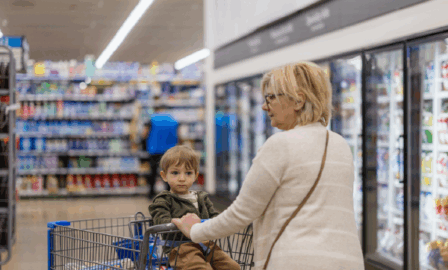Vaccine Distribution and the LGBTQ+ Community
For the LGBTQ+ Community in America, the Covid-19 pandemic is not the first time our community has been devastated by a virus. During the AIDS Crisis in the 1980s, the American queer community, and especially gay men, was decimated by a then unknown virus wreaking havoc with symptoms that were typically only seen in those with compromised immune systems (rare case of pneumonia, aggressive cancer, etc.). Years later this was recognized as what is now known as HIV/AIDS but was then initially called GRID (gay-related immune deficiency). The public response was exactly what one might think would have been at a time when queer rights activism had been halted just a few years prior due to an uprise in opposition. Most folks that were not active allies simply tried their best to ignore the AIDS epidemic and/or contributed to the hateful and negative feelings towards the queer community that only grew as the awareness of the AIDS epidemic grew. The president at that time, Ronald Reagan, did not mention the words AIDS or address the pandemic until 1985 (5 years after the considered starting date of the crisis) and by that time there were estimated 7600 known deaths from AIDS between 1980-1984. Even after there was funding and measures in place to research and help with the AIDS epidemic, the discrimination that queer folk faced contributed to an incredibly negative stigma and distrust towards openly identifying as LGBTQ+, especially with medical professionals. Though this was almost 40 years ago, the effects that this epidemic had on the queer community still linger and can be felt to this day, especially in how the queer community feels toward Covid-19, its treatments, and its vaccines.
Though there may be some hesitation from queer individuals to self-identify on medical forms due to past traumas the queer community has faced or personal fears of discrimination, collecting this data is crucial to ensure equitable distribution of Covid-19 vaccines to all under-represented communities. Individuals of the queer community, particularly Black trans and nonbinary folks and queer people of color experience higher rates of medical negligence and medical discrimination. Not to mention that these folks also tend to have much less access to healthcare due to socioeconomic standings. According to the study “LGBT Poverty in the United States” by the Williams Institute of UCLA, Black transgender individuals experience poverty at a rate of 40% compared to a 16% poverty rate experienced by the straight and cisgender community. Latinx transgender adults experience poverty at an even higher rate of 45%.
Through the same data used in the study by the Williams Institute, the HRC published an analysis that found that 1 in 5 queer adults did not see a doctor when needed due to unaffordable costs and the rates for Black LGBTQ+ adults, Latinx LGBTQ+ adults, and transgender women were even higher at rates of 23%, 24%, and 29% respectfully. The HRC also found that 17% of queer identifying adults did not have any health insurance coverage while their straight and cisgender counterparts experience this at a rate of 12%. As with the other statistics, the rates of no healthcare coverage increase substantially for people of color and transgender folks – queer individuals of color (23%), transgender folks (22%), and 32% of transgender adults of color have no form of health coverage. LGBTQ+ youth are also 120% more likely to experience homelessness when compared to their non-LGBTQ+ youth counterparts. The CDC released a report stating that those in the LGBTQ+ community have “higher self-reported prevalence of several underlying health conditions associated with severe outcomes from Covid-19” than their cis-gender or straight counterparts, essentially saying that the queer community is at a higher risk from Covid-19, healthcare access, or insurance coverage aside. Though since these identities are not collected on any medical forms, the true proportion of LGBTQ+ individuals amongst the population of those with severe Covid-19 symptoms cannot be counted.
COVID-19 Vaccine Distribution
With all these statistics, it’s clear to see that LGBQ+ individuals and especially LGBTQ+ people of color can easily be left out of Covid-19 data collection and treatments. Without collecting the data points of queer representation, an irrefutable case cannot be made that the LGBTQ+ community especially its members of color are being negatively impacted by a lack of Covid-19 vaccines when compared to straight and cisgender counterparts. Without representation in Covid-19 vaccine data, the queer community will be left at the outskirts of vaccine priority and will potentially be erased from discussions of equity and impact in vaccine distribution.
Steps Vaccine Distribution Systems and Medical Providers Can Take to Help:
Though this requires more effort from the state health departments, medical providers as well as registration system developers, here are some suggestions on how to take the extra step and consciously include these under-represented communities in the planning and execution of Covid-19 vaccine distribution:
Even though the stigma facing the queer community has been greatly improved especially in medical spaces, the fear of discrimination still exists for a lot of queer folks. Unlike other identities, many queer folks have the option to “hide” their identity by simply not indicating their queer identity to medical professionals or whomever else they may be interacting with. Steps can be taken to mitigate this fear and possible reaction by medical professionals and vaccine administration registration systems.
The most important step is to ensure confidentiality and safety of the patient. Vaccine administration registration systems can ensure this by providing robust protection of patient data during collection, particularly around gender identity and sexual orientation, as well as transparent advertising of this protection. If the patients do not know the measures being taken to protect their identities and ensure equal levels of care, their fears of discrimination will not be quelled and the potential upsides to creating these extra confidentiality steps will be reduced.
With the federal protection of sexual orientation and gender identity now included as a protected class, there will be a rise in data collection and reporting for this community like there currently are with other under-represented communities. By getting ahead of this curve, vaccine administration registration developers can differentiate themselves in the market from this inclusive standpoint.
Medical providers can also make an effort to clearly demonstrate allyship to the queer community, especially the queer folks of color. This can take the form of testimonials on websites or robust statements of anti-discrimination practices on advertisements. Medical volunteering outreach programs could even help establish strong relationships with local communities and allow for a greater flow of trust, information and better patient care.
By allowing folks to self-identify with gender identity and sexual orientation, vaccine administration registration system providers allow analysts to interact with vaccine distribution data with another filter to look for potential gaps in vaccine administration registration systems. Knowing that there are gaps in healthcare access to the LGBTQ+ community, especially those of color within the community, it is a logical next step to assume that there will be gaps in vaccine distribution to these same communities. However, by collecting these identity data points, we can start pinpointing how to mitigate and rectify these gaps more accurately and efficiently to ensure more equal access to the Covid-19 vaccine.
There will come a time in the vaccine distribution process where the vaccine manufacturers go from the “pandemic” mindset to “post-pandemic” mindset. While in the “pandemic” mindset, the CDC is the main entity requesting vaccines from the manufacturer. The volume of the CDC requests is based on requests to them by state departments who are simply distributing vaccines based on need that is indicated by their data processing based on location, gender, race, and other identifiers. When the switch flips and the vaccine manufacturers go into “post-pandemic” mindset, the vaccine then becomes commercialized because private companies enter the equation of requesting vaccines from the manufacturers. When private companies enter the vaccine request queue along with the CDC, the manufacturers shift their focus to commercial sales and profit which then increase the cost of the vaccines and the CDC is then forced to pay those new prices.
Because the CDC is serving those without private health insurance at this point, the cost burden of this commercialization switch then falls onto the shoulders of these individuals. We know that a disproportionate amount of queer folks do not have access to healthcare or health insurance so it is imperative that the LGBTQ+ community is focused on during the “pandemic” mindset and that they are included in equitable distribution efforts. Otherwise, many folks in this community will be unable to get the vaccine due to the sheer reason of being unable to afford the vaccine. If, by that point, the majority of the US population is vaccinated, the populations that will continue to be hurt and suffer from Covid-19 cases and Covid-related deaths will be those that cannot afford the vaccine like so many folks in the queer community.
Subscribe to Clarkston's Insights
Contributions by Brandon Miller, Maggie Seeds, and Julie Kimbrough



